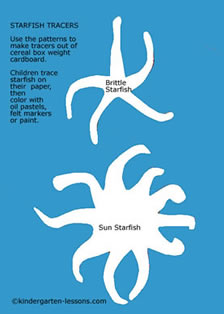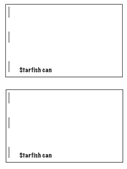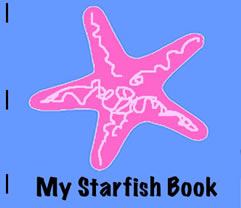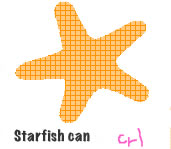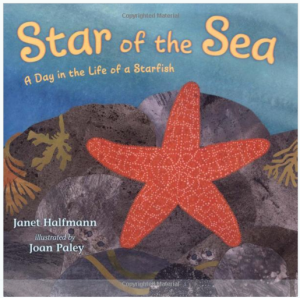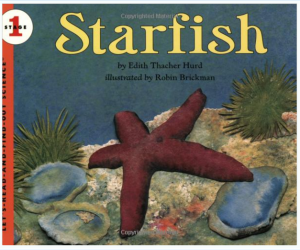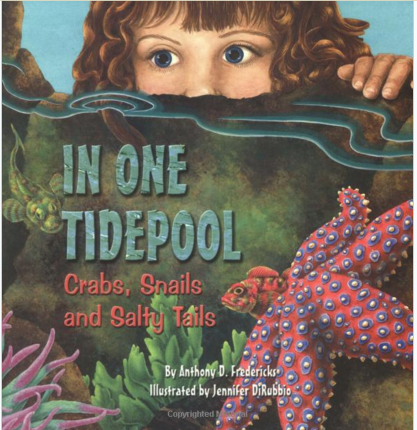Use the four free starfish for kids patterns below to make tracers for children’s art. First, cut out the patterns and trace them on lightweight cardboard. Then cut out 2 or 3 of the four different starfish for classroom tracers.
Children can arrange the tracers on their paper with a ball of tape to hold them steady, trace with a felt marker, color or paint their picture and embellish their dried pictures starfish with sequins and glitter.
If your students are ready, talk about overlapping the starfish shapes for a more interesting picture. Mix a bit of gold glitter in with sandy yellow paint to paint the background. It looks like the bottom of the ocean is glittering in the sun.
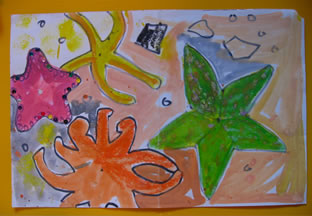
Making Starfish Art Tips!
- Leave small rounds of tape on the table for children to put on the tracers. It holds them steady.
- Have children use dark felt markers to trace rather than pencil as their lines will show up more prominently for painting or coloring later on.
- Omit a few legs from the sunstar tracer if children find it difficult.
Click on the images below to download the starfish tracers.
Literacy center mini-book:
After reading some of the books below and teaching about starfish, make a class chart showing all the actions that a starfish can do, such as walk, grow, eat, crawl, grip, suck water, attack. Print the words clearly beside a drawing for each one.
Then have the students make mini books about starfish. Children can add more or fewer pages according to their abilities. Children print the words from the chart.
Starfish for kids mini-book materials:
- starfish tracers that are about 4″ round
- 5″ squares wallpaper samples or magazine samples
- scissors
- glue sticks
- felt markers
- precut stiffer paper for booklet covers
- stapler
- paper for pages 8.5 x 11 cut in half like image on right
Procedure:
- Children
- choose 3 or 4 pieces of wallpaper and staple them together with one staple
- trace starfish on the top of the pile of stapled wallpaper
- cut through all the stack of papers at once
- glue one starfish on each page (apply the glue to the back of the starfish not to the pages or else the book will stick together!)
If cutting through the stack of papers is too difficult, have children cut out one at a time or ask a parent helper to precut the starfish.
Starfish books for kids
Emergent readers can experience the world of marine biologists in the books below, which include crabs, jellyfish, and starfish.
Star of the Sea: A Day in the Life of a Starfish
With the ocean her home, an ochre sea star hunts for her morning meal. She folds over her rays and grips the rocky shore with sticky feet as she feasts on shellfish. When she takes too long, the tide flows back without her and Sea Star becomes easy prey.
She is built to survive and eventually makes her way back to the sea, although with one less ray than before. This inspiring story informs young children about the important role of a small but fascinating sea creature.
Starfish (Let’s-Read-and-Find-Out Science)
Starfish have arms, but no legs. They have feet, but no toes. Starfish aren’t fish, but they are living animals. Kids learn how starfish move, eat, and grow in Edith Hurd’s poetic text, illustrated with Robin Brickman’s vivid watercolor collages. This is a Stage 1 Let’s-Read-and-Find-Out, which means the book explains simple science concepts for preschoolers and kindergarten students.
Sea Stars (Powerkids Readers: Fun Fish)
About 10 short sentences are in each of this series of readers. Children learn that a group of rays is called a fever; jellyfish and sea stars “are not true fish”; male sea horses give birth; all clownfish are born male; and the first goldfish were silver. On each spread, one or two sentences face a colorful, clear photo.
Each book displays at least one human with the subject, which makes for good, visual size comparison.
In One Tidepool: Crabs, Snails, and Salty Tails (Sharing Nature With Children Book)
Not exclusively about starfish. A little girl peers into a tidepool and observes the animals living there. The book introduces barnacles, fish, anemones, a sponge, snails, crabs, limpets, as well as a sea star.
A page of field notes gives brief information about each of the animals. Full-bleed, double-page illustrations are bright and detailed, bordering on the surreal in color and pattern.

